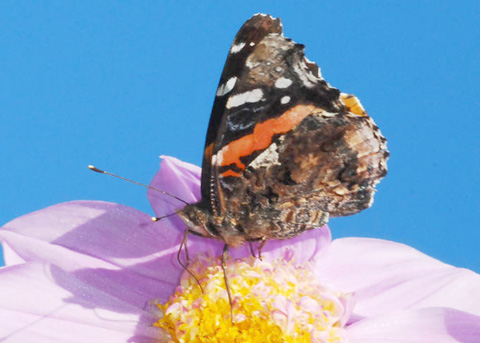 © Peter J. Bryant. |
Red Admiral Vanessa atalanta rubria Lepidoptera: Nymphalidae Back to Butterflies of Orange County, California |
 Hill-topping male.
San Mateo State Park, Orange County, CA. 1/5/13. © Robert Gorman.
|
Fullerton Arboretum, Fullerton, Orange County, CA. 3-31-09. © Ron Hemberger |
 Fullerton Arboretum, Fullerton, Orange County, CA. 11-15-09. © Ron Hemberger |
 Fullerton Arboretum, Fullerton, Orange County, CA. 11-15-09. © Ron Hemberger |
|
|
|
Characteristics: Black with a marginal orange border on dorsal hindwing. Dorsal forewing black with white markings in the apical and subapical regions of the wings and a transverse orange band crossing the wing below these markings. Similar Species: The Red Admiral should not be mistaken for any other butterfly. The distinct orange band across the dorsal forewing makes identification of this species easy. Habitats, Behavior: F. M. Brown (Pyle, 1974) remarks that "atalanta is fidgety, flying swiftly with sharp course changes, and is friendly in the garden, approaching and perching on people." I recall an article in the Los Angeles Times a few years ago, relating to a case of a Red Admiral which "became friends" with a small boy, perching on his head whenever he went outdoors, a daily affair which lasted for approximately one month. A more probable explanation is that the butterfly was attracted to the boy simply because he was a good perching substrate. The adults are said to be especially fond of composite flowers for nectaring (Pyle, 1974). Distribution: Pyle (1974) appropriately describes the Red Admiral as a species which "may be looked for anywhere but expected nowhere." In Orange County, we find it at lower elevations in suburbs, foothill canyons and semi-disturbed areas. Strangely, it seems absent from some of the canyons of the Santa Ana Mountains, although nettle grows in these areas. Big Canyon at Upper Newport Bay is the only area that I know of where one can be reasonably assured of seeing atalanta. A patch of nettle grows in the canyon near Jamboree Road, and this probably serves as the larval foodplant for this colony. Flight Period: We have records for every month although the species seems to be more common during the spring months (March-April) and in the fall (October November); multiple brooded. Ron Vanderhoff records it in 1974 as flying from May to December in Huntington Beach (in 1975 fairly common from June to August; rare in September and October). Larval Foodplants: Nettle (Urtica holosericea) and Hops (Humulus lupulus) are most often cited. Vanderhoff found larvae on Urtica sp. at the Santa Ana River in Costa Mesa. However, Urtica is almost never found in the suburbs where atalanta is common. This may perhaps be partly explained by Hogue's observation of larvae feeding on the ornamental "Baby Tears" (Soleirolia soleirolii) in the suburbs (Emmel and Emmel, 1973). Other foodplants may also be utilized and the adults may stray into areas where they do not breed. Other Remarks: This butterfly is found in Europe as well as North America. See Butterflies of the Nettle Patch. Text from Orsak, L. J. (1977). The Butterflies of Orange County, California. Center for Pathobiology Miscellaneous Publication #3. University of California Press, New York. 349pp. The Red Admiral and Painted Lady Web site Return to Butterflies and their larval foodplants |
|


